|
Normacot - “I wouldn’t live anywhere else,”
The old lane through the Potteries used to end at Normacot. The distance to Goldenhill from here is about 11 miles, or a one and sixpenny bus ride in old money through Hanley, the City Centre.
But there is one event that connects the two villages and that is the appearance in North Staffordshire of Henry Audley whose riches came from the land-grab that followed the Norman invasion. Henry lived in the time of King John, and in 1223 he bestowed upon the Cistercian monks of Abbey Hulton large tracts of land in the hope he could book an easy ride to God’s own city centre. So Henry greased the abbot’s palm with land ranging from Goldenhill to Normacot which covered very well indeed the price of his travel ticket.
Until 1883 Normacot resided in the parish of Stone. Its first eminent resident was Ralph Bailey who lived at Normacot Grange in the late 1600’s. Obadiah Lane occupied the house in 1703 when the first coal mines in this district were worked – the house and mines were later sold to the Edensor-Heathcotes.
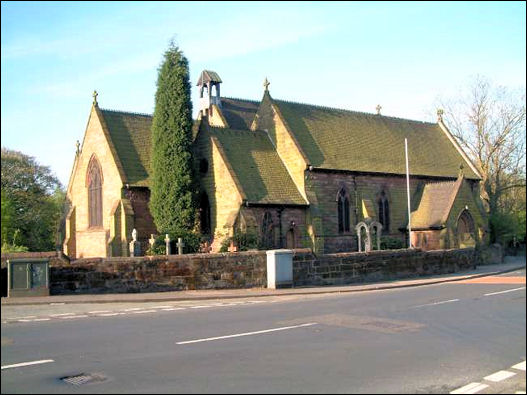
Church of the Holy
Evangelists, Normacot
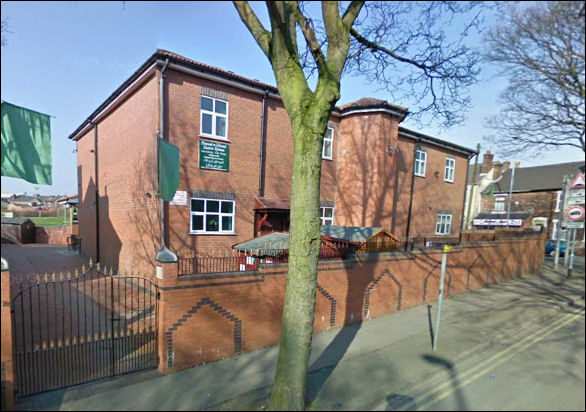
Gallani Noor Mosque -
corner of Chaplin Road and Upper Normacot Road
Google Street View
The Church of the Holy Evangelists, at the head of Upper Belgrave Road, was built in 1847 under instructions from the Duke of Sutherland. Its architecture is characteristic of the Early English style. The connected graveyard is also the embodiment of Englishness in this bucolic corner of industrial Stoke on Trent. But the most remarkable fact is that this English pastoral landscape also sits at the very heart of one of Stoke on Trent’s most successful and thriving Muslim communities. Just down the street from the English church stands the newly built Gallani Noor Mosque which is the Islamic centre for the Longton district.
To add another slice of irony to this fantastic location I should tell you that just seventy years ago the leader of the British Union of Fascists, Black Shirt Oswald Moseley, stood on this very spot and composed his own loathsome ideology of right-wing superiority, for this grand house, the Islamic Centre, was once the constituency home of the British Nazi where Moseley’s wife, Lady Cynthia, worked and lived as Stoke South’s Member of Parliament.

Time has not changed the architectural edifices. The same stretched rows of lower-middleclass terraces that long ago accommodated individuals who once must have known the Moseley’s, are today occupied by conscientious Pakistanis innocently unaware of the ironic coincidence that timeless fate has given them to share.
Mazar Hussain has lived in Normacot for 33 years and was educated at Longton High School. He and his wife Parveen Kausar Hussain have lived near the Mosque for 18 years where they converted a corner shop to become their house. And across the road is their successful textile business. Not only are they proud of their achievements but they are also proud of the community they have helped to build.
“We have seen many families come to this district and integrate with Normacot residents,” comments Parveen, “And it has been a big success story.”
Indeed as I walk along Chaplin Road and Hamilton Road, through streets that have benefited from housing development grants, it is enchanting to see the friendly exchange of legitimate familiarity between ethnically diverse residents.
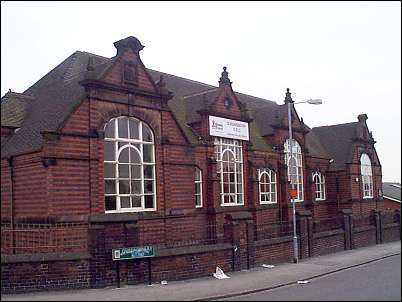
Queensberry School
Around the corner is Queensberry School where I meet up with Joan Bell who was born in Normacot and has lived here all her life. “I wouldn’t live anywhere else,” she says with obvious pride.
Over a decade ago the council had made a decision to demolish this old Victorian School. The plans outraged Normacot people so much that they formed an action group led at the time by Joan who was then their local Labour councillor. The hard-fought battle reversed the council’s decision and Queensberry set sail as the new flagship of Stoke-on-Trent’s community policy. Today the former Victorian school is the centre of neighbourhood inclusion and the popularity of the foundation is proof-positive of the resident’s success.
“At the end of the day,” avers Joan, “It’s all about people’s aspirations and their determination not to settle for anything but the best.”
As in Fenton, the newly opened A50 has caused enormous problems. When it was being laid out it took away people’s homes, tearing through the village creating divisive problems with relocation. Joan says, “Everyone at the time was opposed to the new A50, but like good citizens we’ve moved on since then and the greater community is the better for it. There are many sections and individuals who are now engaged in community development that weren’t around before. Now I don’t think there’s anywhere in Stoke on Trent that is as commonly united as Normacot.”
 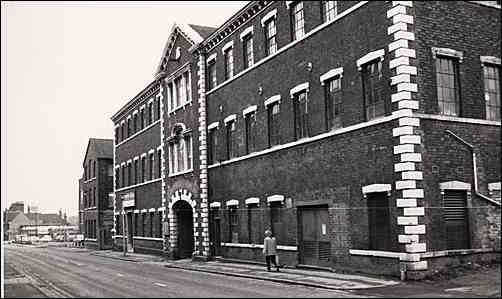
Aynsley's Portland
Works in Sutherland Road, Longton.
© Staffs Past-Track
Normacot is the original Aynesley China land. Just on the southern tip of Longton generations of pottery workers grew up working at the pot-banks and the pits, though now there is nothing left to see of industrial Normacot. The Aynsley Denton works is marked down as an old building these days occupied by other trades. Pot-banks have disappeared unremembered and forgotten by a changing society in a township that’s suddenly become freer of traffic and less polluted.
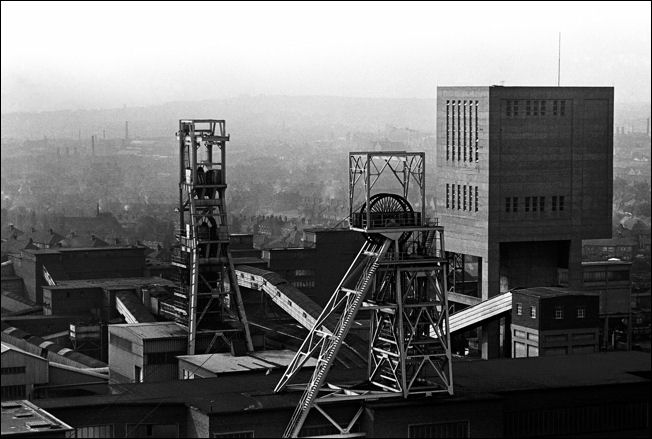
Florence Colliery &
in the background - Longton
photo: 1969 - Ken & Joan Davis
Of course Normacot isn’t new to upheaval. The bitter closure of Florence colliery in the 1980s caused job losses that influenced the whole social, industrial and retail aspects of this area. And these changes are startling. I can’t think of anywhere else I’ve travelled to in the Potteries that has seen its environmental appearance transform so much for the better.
Where the colliery once stood a huge modern housing estate now winds up to the base of the high hills above Lightwood. Wasteland has been reclaimed and smartened-up; factories have been rooted out and there is brightness everywhere. But it is the social change that is really outstanding.
Joan Bell is certain that the transparent use of high investment has repaid the aspirations of the local population and has given the land and the people a positive and sunny outlook. The Normacot of the 21st century is the result of strong community affiliations. Residents continue to press as one for educational and social investment. And because community involvement has been so irresistible the council follow-up support has been positive. It is a success story that’s ongoing and I am impressed by Joan’s unambiguous comment – “Multiculturalism and community respect makes us richer.”
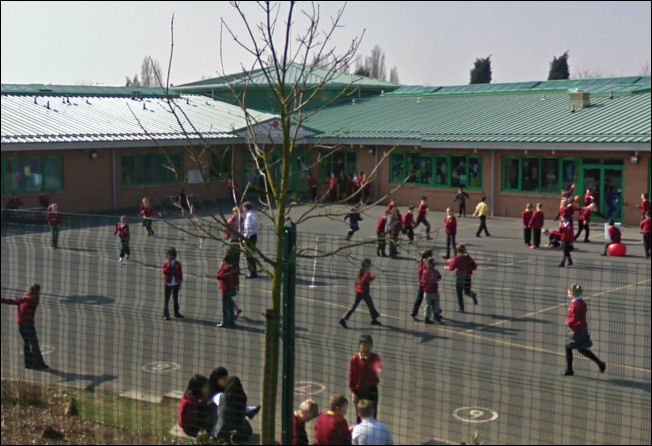
Belgrave CE
Primary School, Sussex Place, Longton
Google Street View

Dresden and Florence Schools were demolished and amalgamated in 2002 to make way for the new Alexandra school. And the brand new Belgrave CE Community School has replaced the old Normacot CE where Joan is appropriately chair of governors. The new schools are more than State of the Art replacements – they are held up as icons of Stoke on Trent’s ground-breaking infant and junior educational policies.
At Belgrave I meet school caretaker, Mike Crooke, who is proud of his technical tasks. He eulogises for instance over the under-floor heating ‘flowing from the lobby area through the corridors and the classrooms.’ But his chest physically expands as he describes the other novel features. “The roofing,” he says, “is daylight-illuminated and is receptive to natural conditions by solar panels to provide the school’s hot water system.
And we have the innovation of rainwater recycling which allows water to run from the roof through the gutters and pipes into a storage area where it is filtered into tanks to provide toilet flushing.” Mike plunges on waving not drowning but losing me amid a waterfall of techno-jargon.
The ratio of Asian pupils at Belgrave is 40 percent to other children which comparatively reflects the proportion of Asian families in Normacot. As in all schools, new and ‘gob-smacking’ hi-tech education appears to be the norm. Community links officer, Iftahal Ahmed, has successfully nominated the school for the finals of an award for minority integrated accomplishment. And like the caretaker’s fluid enthusiasm, friendliness runs here un-breached.
The school bursar, who likes to be known as Kath, came from old Florence school and tells me there are 483 children in Belgrave School none of whom now remembers the former Victorian buildings. Still she has a soft-spot for tradition. “The old schoolrooms were lovely in their own way,” she says, “but they ended up becoming all corridors and portable extensions. Belgrave, as you can see, is modern, warm and airy.”
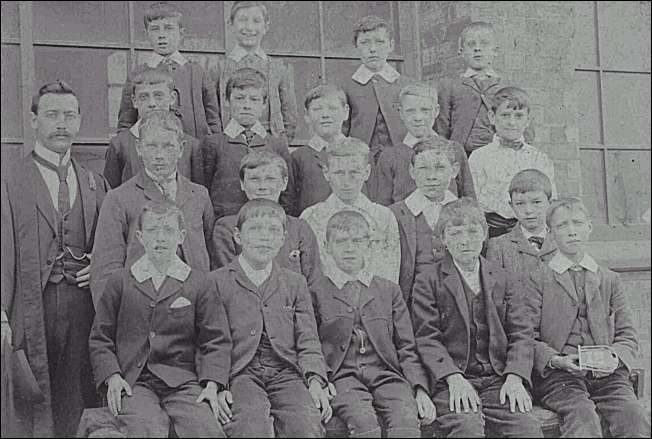
Queensberry Road
Secondary School
2nd row centre, in white shirt, is Reginald Mitchell (the designer of
the Spitfire plane)
photo: Eileen Hallam
I return to the Victorian Queensbury where, buried in the centre of the old school buildings, is ‘Studio Q’, a dedicated sound studio for youth from all over Stoke-on-Trent between the ages of 13 and 25. It has space for bands to record and facilities to make CD’s with professional advice and supervision. “Here kids can learn the skills of performance, recording and how to be a DJ. We make demos for bands and hopefully we make stars,” 18 year old James Davis, a music technician and youth worker assures me. “We also run courses for beginners through to becoming experienced musicians from this base,” he adds.
There is a historic clue to the engineering success of Queensberry and Normacot and I found it written on a bronze plaque in the main hall where the name of Reginald J Mitchell the designer of the Spitfire is inscribed. In such a modern and vibrant community where so much is going on I may be forgiven for failing to remember that this great Briton spent his formative years at this school from 1905 to 1909.
Fred Hughes

|
![]()
![]()
![]()